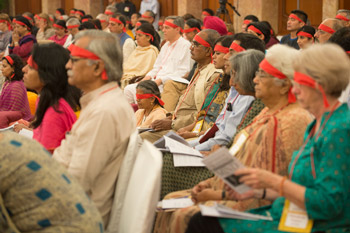New Delhi, India, 23 March 2014 - On the final morning of a short series of teachings His Holiness the Dalai Lama has been giving in Delhi at the request of the Foundation for Universal Responsibility he gave a Trisamayavyuharaja empowerment. All seats in the hall were filled as more than 300 people sat quietly while His Holiness undertook the preparatory rituals. When he was ready he began to explain:
“Today’s teaching is from the Tantrayana. If we look back in history there has long been some controversy about the status of both the Mahayana and Tantrayana. Nagarjuna defended the authenticity of the Mahayana, asserting that it was indeed the teaching of the Buddha. Maitreya, Bhavaviveka and later Shantideva all confirmed Mahayana’s being the authentic teaching of the Buddha.”

|
His Holiness the Dalai Lama during the final day of his three day teaching in New Delhi, India on March 23, 2014. Photo/Tenzin Choejor/OHHDL
|
His Holiness explained that in the Vinaya, which is preserved in the Pali tradition, monks are accorded the highest reverence. In the Mahayana of the Sanskrit tradition both lay men and women are also accorded respect.
“In Taiwan and China today there are some who still challenge the authenticity of the Mahayana and this is true to some extent in countries that follow the Pali tradition. The action, performance and yoga tantras have been practised in China, Japan, Korea and Vietnam, but in these countries there has been a diffusion of traditions. For example, Zen is separate from the Japanese tantric traditions. In Tibet, the Vinaya is the basis on which the Bodhisattva’s practices are done in conjunction with the practice of tantra. It is characteristic of Tibetan Buddhism that all three vehicles are integrated and practised together.”
Recalling a Western scholar’s qualms about the authenticity of the Mahayana at a conference in Delhi, His Holiness reported that he had suggested that Indian scholars like Nagarjuna living only four centuries after the Buddha were in a better position to judge. The evidence of his writings shows that Nagarjuna was sceptical and scientific in his approach to such questions.
His Holiness digressed to admit that his own scientific investigations have led him to reject certain traditional Buddhist doctrines. Although he memorized Vasabandhu’s ‘Treasury of Knowledge’ when he was young, he no longer believes in the cosmological explanations found in Chapter 3 regarding the existence of Mt Meru, a flat earth and measurements related to the sun and moon. The scriptural accounts do not accord with empirical scientific observation. However, he remarked that explanations of the Four Noble Truths and emptiness are far more important. And with regard to understanding these topics and the final destination of Buddhahood scholars of the Mahayana and Sanskrit traditions are immensely helpful. He said reading their accounts makes you feel that attaining Buddhahood is possible.
“Negative emotions can be overcome by antidotes that involve relatively coarse aspects of the mind, but their imprints can only be eliminated by the subtle mind. The possibility of actually doing this is revealed in the Highest Yoga Tantra explanations of the clear light and subtle body, speech and mind.”

|
Members of the audience wearing symbolic blindfolds during the final day of His Holiness the Dalai Lama's three day teaching in New Delhi, India on March 23, 2014. Photo/Tenzin Choejor/OHHDL
|
His Holiness pointed out that the word ‘mantra’ means something like ‘mind protector’, the basis of which is understanding emptiness, which protects the mind from ignorance and ordinary appearance. Achieving this is again related to the subtle mind. As an example of employing the subtle mind he cited the case of the 18th century lama Changkya Rolpai Dorje whose sight declined in his later years to the point where he could no longer read. To overcome this difficulty he used to arrange to employ his dream body to do his reading during dream time.
The same lama featured in another story His Holiness told of Tagphu Tenpai Gyaltsen, a lama reputed for his clairvoyance. Changkya Rolpai Dorje decided to test him by asking him to describe what he, Changkya, had in his pocket. Tagphu Rinpoche duly described a rosary. When Changkya asked how he knew, he said he would focus on what he wanted to know, then first a bell would appear to him followed by whatever object he was investigating.
As a preliminary to the empowerment, His Holiness asked those assembled to join him in reciting the Heart Sutra dharani - Gate, gate, paragate, parasamgate, bodhi svaha, which he had already explained to them. In the course of the empowerment he also bestowed the Bodhisattva vows. At the end he said:
“That’s it for this year. I look forward to seeing you again next year and hope that in the meantime there will have been a steady increase of inner strength.” 